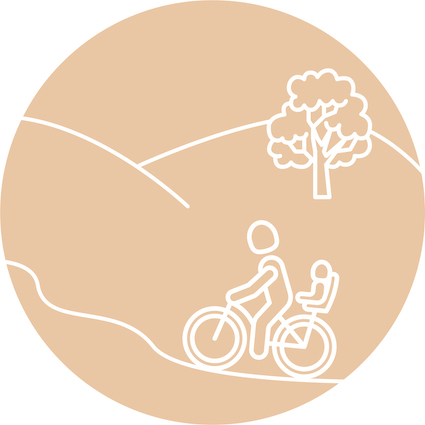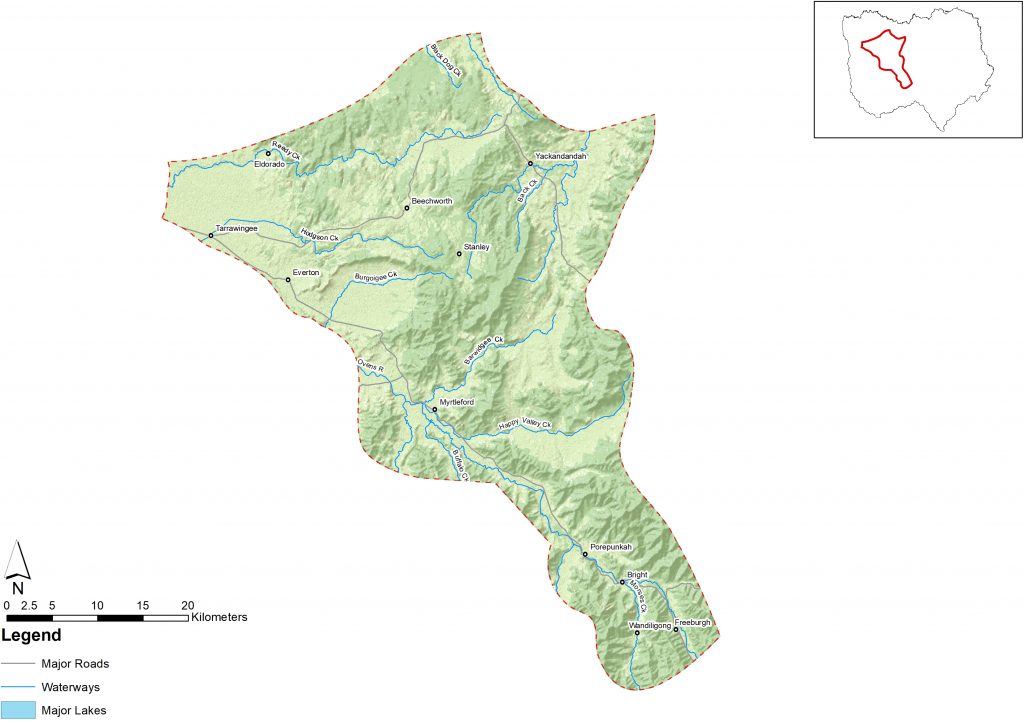
Vision
Active local and visiting communities supporting sensitive recreation and development that maintains cultural and natural values
Introduction
This landscape hosts both forested hills and fertile valleys that support a variety of agriculture including grazing, beef, horticulture, hops and soft wood plantations. In comparison with other areas in north east Victoria, farm holdings are smaller and land values are rising.
Regional towns include Bright, Myrtleford, Beechworth and Yackandandah with many other smaller towns across the landscape. Many of these towns are tourism hotspots for recreational fishing, biking, swimming, bushwalking and general tourism.
There is modest population growth and an ageing population. The population structure around Myrtleford reflects the region’s tobacco growing past with relatively high cultural diversity, compared with other landscapes in north east Victoria.

What is important?
Important attributes
Important attributes of this landscape identified by those who live, work, visit or connect with this landscape include:
- Hosts a variety of agriculture including grazing, beef and hops with increasing small-scale horticulture, farm-to-plate produce and agri-tourism
- Rolling hills and valleys, wild rivers, grassy woodlands lining rivers as well as Yellow Box forests and old paddock trees scattered throughout farmscapes
- The Yeddonba Aboriginal Cultural Site near Mt Pilot is considered a sacred site by Traditional Owners/First Nations Peoples
- The heritage-listed Ovens River provides one of the most resilient natural refuges for aquatic life in the Murray-Darling Basin, as well as a high recreation and lifestyle value for the community
- Year-round nature and adventure-based activities and scenic landscapes including views of the alps and mountains
- Town centres have a strong heritage value with original buildings and a celebration of historical culture, particularly in Beechworth and Yackandandah
- Towns, wineries, gourmet produce and restaurants celebrate local produce and boutique industries.
Key features
| Theme | Key features |
|---|---|
| Land | This riparian corridor is characterised by a mix of forested hills, steeper mountains and fertile valleys. Agricultural land use consists of grazing, dairy and some cropping. Tracts of softwood plantations are present throughout this landscape. In several localities, alluvial outwashes provide deeper soils. |
| Water | Priority waterways are the Ovens River, Buckland River and Buffalo River. The Ovens River acts as the main waterway with the Buckland and Buffalo rivers’ merging with it, as well as a network of smaller creek systems. The Buffalo system is the only regulated river in the landscape, where periodic water releases from Lake Buffalo (23,340 ML capacity) affects flow regimes downstream. Billabongs and other wetlands are common around the Hodgson Creek and Happy Valley Creek areas and deep freshwater marshes or freshwater meadows also exist along the Ovens River system. Groundwater is a highly reliable source of water in this landscape and in the upper reaches is highly inter-connected to the surface waterways. |
| Biodiversity | The Chiltern-Mount Pilot National Park on the northern edge of this landscape is an important remnant of native vegetation, particularly Box-Ironbark forest. Large older remnant, ancient and paddock trees are important habitat connectivity features. Some important species and communities that are significant to this landscape include: Flora Box-Ironbark forests Beechworth Silver Stringybark (Eucalyptus aff. cinerea) Crimson spider orchid (Caladenia concolor) Terrestrial fauna Brush-tail phascogale (Phascogale tapoatafa) Barking owl (Ninox connivens) Regent honeyeater (Anthochaera phrygia) Grey-crowned babbler (Pomatostomus temporalis) Koala (Phascolarctos cinereus) Aquatic/riparian/wetland fauna Trout cod (Maccullochella macquariensis) Spotted tree frog (Litoria spenceri). |
| Community/socio-economic | This landscape consists of towns Beechworth, Yackandandah, Myrtleford and Bright which are important economic hub and lifestyle locations. High percentage of unoccupied dwellings as a percentage of all dwellings reflecting weekender nature of visitors. Seven Landcare groups in this region support volunteer contributions to land management. Beechworth and Porepunkah have the lowest proportion of Indigenous peoples with less than 1% of the population recorded in the census. More than 16% of Myrtleford residents were born overseas, the highest percentage of any town in north east Victoria. Most of this landscape has no formally recognised RAP. |
Condition
The following is a snapshot of condition for the Rural Lifestyle, Tourism and Production Landscape.
| Land | 11% of land has a pH under 4.4 (extremely acid) and 84% of land has a pH between 4.4 and 4.9 (strongly acidic).[63] The acidic topsoil condition is declining in areas affected by the 2019-20 bushfires. Rapid growth and increase in land managed for lifestyle, rural residential and urban uses is reducing native environmental landcover and altering the landscape amenity. Level of revegetation on private land is low but shielded by high proportion of vegetation on public land. |
| Water | Streams are considered as being in good to moderate condition. Slight improvement in waterway health, but majority of priority waterways remain accessible to stock grazing. Happy Valley Creek has a severely depleted in-stream woody habitat and is in very poor condition. The Ovens River is in a moderate condition with stretches of highly depleted in-stream woody habitat. A series of bushfires has impacted the river systems in this landscape with sediment and debris runoff from the Mt Buffalo fire complex in 2019-20 impacting water quality. Multiple size classes of trout, including mature and some young-of-year fish, indicating that conditions in the Ovens River are supporting the survival of this species throughout its lifecycle. Groundwater in the Ovens River system is considered as stable with high reliability. |
| Biodiversity | Biodiversity condition is concerning with decreasing populations and distributions of threatened aquatic species including trout cod, silver perch, catfish, Macquarie perch, Murray cod, Murray river rainbowfish and Murray spiny crayfish. The construction of fishways to reduce barriers to fish movement at Tea Gardens and Bright have been funded and will increase movement and population stability of fish in the Ovens River system. Box-Ironbark forests are threatened, resulting from a legacy of intensive land clearing for agriculture in the region. Similarly, species of native fauna and flora that depend on native forests are threatened and in decline e.g., brush-tailed phascogale (Phascogale tapoatafa). The threatened crimson spider-orchid (Caladenia concolor) occurs in the Beechworth area. The Chiltern-Mt Pilot National Park reserves some of the few remaining wild individuals of this species. The Chiltern-Mt Pilot National Park is in relatively good condition despite mining history and associated weed occurrences. Control of invasive plant species (predominantly blackberry) on private land is holding stable due to the diligence of landholders and the effectiveness of current practices. Control of rabbits and wild dogs is holding stable on private land but increasing concern regarding the impact of deer and limit of control measures. Development and land clearing is impacting negatively on habitat connectivity. |
| Community/socio economic | Strong Landcare community, alongside new environmental volunteer groups such as Totally Renewable Yackandandah and Beechworth. High multiculturalism and diversity. High proportion of visitors, people in non-private housing, unoccupied dwellings and employment in accommodation, cafes, arts and recreation.[64] Communities are recovering from the shock of the 2019-20 fires, as well as the impacts of COVID-19 lockdowns and social isolation. Significant increase in the proportion of the population with degree level education, over the past 30 years. The increase in degree holding people in Yackandandah is significant – in 1986 this was 7% of the population, rising to 30% in 2016. Bright, Porepunkah, Beechworth and Yackandandah all have high rates of population growth and urban development.[65] Strong support for Indigenous youth with employment and skills building programs in Bright. Decline in employment in agriculture and manufacturing towards increasingly services-based employment. |
What is changing?
The world and our region are changing rapidly and north east Victoria is more interconnected across multiple spatial scales than ever before.
This section describes the major drivers of change identified by Traditional Owners/First Nations Peoples and the community during a range of engagement activities undertaken to develop the RCS, and what this means for the Rural Living, Tourism and Production landscape.
Drivers of change
| Driver of change | Leading to |
| Climate change and acute shocks and extreme events | Increased extreme heat events, with more frequent days over 38oC leading to heat stress impacts across the landscape. Increased frequency of extreme events including storms, floods, droughts, fire and blue green algae. COVID-19 lockdowns and smoke from bushfires impacting on visitation and tourism industries. Retracting areas with snow cover leading to changes in ski season and tourism – opportunity to expand summary tourism in resort areas. Increased fear of falling trees and vegetation causing fire risk, leading to increased clearing of native vegetation and other habitat. Community is forming groups to support climate mitigation and students and young people are demonstrating for climate change action. Declining average rainfall and reduced stream flow in waterways. |
| Land use change and gentrification of rural townships | Competing demand for recreation, lifestyle and productive land use. Housing development at the expense of agricultural land availability in urban fringes. Long-term population growth predictions eventuating sooner than expected. Urbanisation, land clearing and tree removal threatens ecosystems and connectivity between landscapes. Increased incomes and wealth in townships creating demand for recreation and modern cultural experiences. Increasing community expectations for improved liveability and services. |
| Growth of tourism industry and increased visitor numbers | Contributes to regional growth and provides opportunity to improve recreation and tourism infrastructure. Increase in diversity of how people engage with nature and expectations for services. Impacts of physical degradation, littering, noise, trampling vegetation, introduction and spread of weeds, fungi etc. People engaging with, and valuing nature and natural environment. Opportunities for eco-tourism and eco-volunteering. Absentee and seasonal residents who are difficult to engage in NRM opportunities. |
| Shift to the service economy | Declining populations of larger-scale farming operations. Greater demand for tourism, hospitality, and accommodation services workers. Reliance on advancing technology to facilitate new and fast-moving expectations in service and convenience. Higher demand for mobile and telecommunications infrastructure is outpacing improvements of blackspot areas and bandwidth issues. |
| Change in governance | Empowerment and self-determination of Traditional Owners/First Nations Peoples is being integrated into planning and community decision making. Recognition of Traditional Owners as RAPs is often contested between multiple Traditional Owners/First Nations groups. Potential increases in public access to Crown land water frontages with grazing licences. Community groups and engagement events are incorporated into local government and agency planning. Multi-agency framework for emergency management is complicating community perception of how extreme weather events are managed. Bushfire Recovery Victoria establishing Community Recovery Committees across the landscape. |
| Increasing invasive pest plants and animals | Increasing populations of herbivores including deer impacting on native vegetation and increasing the spread of weeds due to bare ground. Increasing infestation of problem weed species such as blackberries. Self-organised community driven initiatives to control invasive pest plants and animals. |
Outcomes and priority directions
Key outcomes and priority directions for the RCS have been developed, drawing on information and discussions with people who live, work, visit and connect with north east Victoria.
Outcomes and their associated priority directions, that are important to the Rural Living, Tourism and Production landscape from the regional themes of biodiversity, water, land and community include:
Biodiversity
- By 2040, an increase in the extent (ha) and connectivity of native vegetation across north east Victoria.
- By 2040, an increase in the area of natural environments protected and remnant vegetation enhanced.
- By 2040, improved trajectories for priority native icon, threatened and culturally significant species and ecological communities (priority species and communities).
- By 2040, an increase in the understanding and focus on supporting resilient biodiversity in a changing climate.
Land
- By 2040, land management practices are culturally appropriate reflecting Traditional Owners/First Nations Peoples aspirations.
- By 2040, community resilience and land management practices are continually adapting to accommodate challenges of climate change and extreme events.
Community
- By 2040, an increase in the number and diversity of individuals and organisations supporting Landcare and Community NRM groups in north east Victoria.
- By 2040, an increase in participation by visitors and absentee landholders caring for, and stewarding the natural environment across north east Victoria.
- By 2040, an increased diversity of investment in NRM in north east Victoria.
- By 2040, Traditional Owners/First Nations Peoples’ knowledge and practice is healing, adapted to a contemporary context and applied to both heal and care for Country.
Water
- By 2040, waterways are healthy and well managed thereby protecting waterway dependent iconic, culturally important and threatened (priority species) species.
- By 2040, there is improved protection of water quality and waterway/wetland/floodplain system values during and following extreme events.


